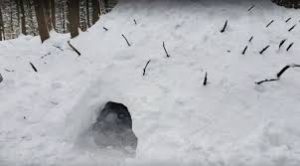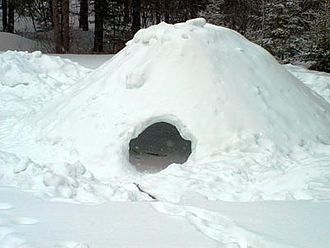HOW TO BUILD A QUINCY SNOW SHELTER
During a winter survival weekend I learned how to make a Quincy snow hut which in fact resembles an igloo. Since that time I have made a few more for fun than survival with my family and some cub scouts. One winter my boys and I made a Quincy in the back yard. It took about four hours. Simulating a wilderness experience we used our snowshoes to both pile a mound of snow and to pack it down until it more resembled a giant scoop of vanilla ice cream. Then we made an entrance and began to excavate removing snow from the interior.
You will also require some thin sticks about 12 – 18 inches in length that should be readily obtained from nearby brush or branches.
Initially we copied Molson’s technique (the family Golden retriever) and began digging and scooping the snow between our legs, behind us. Once inside we continued to pile the scooped snow on a snowshoe which we then passed outside taking turns at excavating or dumping. In a survival situation you have to monitor your effort to prevent sweating for once the sweat cools down it cools you down! That cold, clammy feeling is an enemy to your survival.
At some point we began using curving strokes to conform to the curvature of an igloo. This is when we use those twigs which we pass through the walls to help maintain a consistent thickness and to prevent punching a hole to the exterior. The base should be thicker – for support – than the upper area.

At the back of the interior build a ledge for sitting or sleeping that is higher than the floor where the cold air settles. It’s like a shelf. Don’t forget to block up the entrance to prevent cold air from entering and to maintain a more uniformly warm interior.
Using the tip of a snowshoe, or another larger twig, drill an air hole in the roof. By using a candle in an empty tin can you can glaze the inner surface to increase its strength. Your body heat will also do so. After 24 hours a person – perhaps not a beluga whale in size – can walk all over the roof of your Quincy.
One year a cub master asked me to spend some time with his cub scouts after school and teach them the process. The following school day, during recess, children spent lots of time and effort trying to walk all over the Quincy, like a snow goat, and no one fell through. Some were seen jumping up and down on the roof.
Snow huts (Quincy’s) are petty well sound proof. After the school bell announced an end to recess teachers on yard duty had to trudge through the snow to make sure no one was in the Quincy or they wouldn’t have heard the bell.
In frigid weather, especially enhanced with the wind chill factor, a Quincy effectively deflects the wind and creates a warm (compared to the outside) retreat. A candle in a tin can will provide a little more warmth which is significant in a survival situation. Of course too much heat can melt your Quincy so monitor the candle heat.
A six foot diameter dome can ‘comfortably’ (a relative term) accommodate two adults; depending of course upon their size. When excavating your Quincy a rain suit or nylon snow outer can help keep you exterior dry. Of course you must pay attention to your body heat to avoid sweat. By practising in your backyard you can better learn if a Quincy is worth your while if faced with a survival situation and of course it is better to learn by practice as versus learning when under duress as in a survival situation. In short, don’t procrastinate.
Pile, pack and excavate. It’s a great way to enjoy winter with your family and friends.
The term Quinzhee or Quinzee – add your own spelling – is apparently Athabaskan in origin and refers to a Canadian snow shelter.
